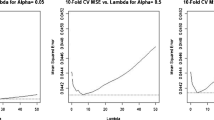Abstract
The degree of accuracy in surgery duration estimation directly impacts on the quality of planned surgical lists. Model selection for the prediction of surgery duration requires technical expertise and significant time and effort. The result is often a collection of viable models, the performance of which varies across different strata of the surgical population. This paper proposes a prediction framework to be used after a comprehensive model selection process has been completed for surgery duration prediction. The framework produces a partition of the surgical cases and a “hybrid model” that allocates different predictors from the collection of viable models to different parts of the surgical population. The intention is a flexible prediction process that can reassign models and adapt as surgical processes change. The framework is tested via a simulation study, and its utility is demonstrated by predicting surgery durations for Ear, Nose and Throat surgeries in a New Zealand hospital. The results indicate that the hybrid model is effective, performing better than standard model selection in two of the three simulation studies, and marginally worse when the selected model was the true underlying process.







Similar content being viewed by others
References
Graue, R. M.: Prediction and optimization techniques to streamline surgical scheduling, Master’s thesis, Massachusetts Institute of Technology United States, 2013
Devi, S. P., Rao, K. S., and Sangeetha, S. S., Prediction of surgery times and scheduling of operation theaters in optholmology department. J. Med. Sys. 36(2):415–430, 2012. https://doi.org/10.1007/s10916-010-9486-z.
Dexter, F., Epstein, R. H., Bayman, E. O., and Ledolter, J., Estimating surgical case durations and making comparisons among facilities: identifying facilities with lower anesthesia professional fees. Anesth. Analg. 116 (5):1103–1115, 2013. https://doi.org/10.1213/ANE.0b013e31828b3813.
ShahabiKargar, Z., Khanna, S., Good, N., Sattar, A., Lind, J., and O’Dwyer, J.: Predicting procedure duration to improve scheduling of elective surgery. In: Pham, D.-N., and Park, S.-B. (Eds.) PRICAI 2014: Trends in Artificial Intelligence. Cham: Springer, ISBN 978-3-319-13560-1, 998–1009. https://doi.org/10.1007/978-3-319-13560-1_86, 2014.
Hosseini, N., Sir, M. Y., Jankowski, C. J., and Pasupathy, K.: Surgical duration estimation via data mining and predictive modeling: a case study, AMIA Annual Symposium Proceedings, 640–648, 2015
Edelman, E. R., van Kuijk, S. M. J., Hamaekers, A. E. W., de Korte, M. J. M., van Merode, G. G., and Buhre, W. F. F. A., Improving the prediction of total surgical procedure time using linear regression modeling. Frontiers in Medicine 4:85, 2017. https://doi.org/10.3389/fmed.2017.00085.
ShahabiKargar, Z., Khanna, S., Sattar, A., and Lind, J.: Improved prediction of procedure duration for elective surgery. In: Ryan, A., Schaper, L. K., and Whetton, S. (Eds.) Integrating and Connecting Care, vol. 239 of Studies in Health Technology and Informatics, IOS Press Ebooks, 133–138. https://doi.org/10.3233/978-1-61499-783-2-133, 2017.
Green, S. B., How many subjects does it take to do a regression analysis. Multivariate Behav. Res. 26(3): 499–510, 2010. https://doi.org/10.1207/s15327906mbr2603_7.
Harrell, F, Regression modeling strategies. 1 ed. New York: Springer, 2001. https://doi.org/10.1007/978-1-4757-3462-1.
Schmidt, F. L., The relative efficiency of regression and simple unit predictor weights in applied differential psychology. Educ. Psychol. Meas. 31(3):699–714, 1971. https://doi.org/10.1177/001316447103100310.
Austin, P. C., and Steyerberg, E. W., The number of subjects per variable required in linear regression analyses. J. Clin. Epidemiol. 68(6):627–636, 2015. https://doi.org/10.1016/j.jclinepi.2014.12.014.
Hansen, B. E., and Racine, J. S., Jackknife model averaging. J. Econom. 167(1):38–46, 2012. https://doi.org/10.1016/j.jeconom.2011.06.019.
Wolpert, D. H., Stacked generalization. Neural Netw. 5(2):241–259, 1992.
Allen, D. M., The relationship between variable selection and data augmentation and a method for prediction. Technometrics 16:125–127, 1974.
Seber, G. A. F., and Lee, A. J., Linear regression analysis. 2 ed. New York: Wiley, 2003.
Khanmohammadi, N., Rezaie, H., Montaseri, M., and Behmanesh, J., The application of multiple linear regression method in reference evapotranspiration trend calculation. Stochastic Environmental Research and Risk Assessment 32(3):661–673, 2018. https://doi.org/10.1007/s00477-017-1378-z.
Theobald, R., and Freeman, S., Is it the intervention or the students? Using linear regression to control for student characteristics in undergraduate STEM education research. CBE Life Sciences Education 13(1):41–48, 2014. https://doi.org/10.1187/cbe-13-07-0136.
R Core Team, R.: A language and environment for statistical computing, R Foundation for Statistical Computing, Vienna, Austria. https://www.R-project.org/, 2018
Alpaydin, E., Introduction to machine learning. 2 ed. Cambridge: The MIT Press, 2010. ISBN 9780262012430.
Author information
Authors and Affiliations
Corresponding author
Ethics declarations
Conflict of interests
All the authors declare that they have no conflicts of interest.
Ethical approval
This article does not contain any studies with human participants performed by any of the authors. All procedures performed in studies involving human participants were in accordance with the ethical standards of the institutional and/or national research committee and with the 1964 Helsinki declaration and its later amendments or comparable ethical standards.
Informed consent
Informed consent was obtained from all individual participants included in the study.
Additional information
Publisher’s Note
Springer Nature remains neutral with regard to jurisdictional claims in published maps and institutional affiliations.
This article is part of the Topical Collection on Systems-Level Quality Improvement
Rights and permissions
About this article
Cite this article
Soh, K.W., Walker, C., O’Sullivan, M. et al. An Evaluation of the Hybrid Model for Predicting Surgery Duration. J Med Syst 44, 42 (2020). https://doi.org/10.1007/s10916-019-1501-4
Received:
Accepted:
Published:
DOI: https://doi.org/10.1007/s10916-019-1501-4




